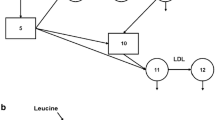Abstract
Atherosclerosis, with the attendant consequences of coronary heart disease and stroke, is the major cause of death in the United States and most developed countries. Elevated serum cholesterol and, in particular, the low-density lipoprotein (LDL) fraction is a major risk factor in the development of arteriosclerotic disease in both animals and humans (Consensus Conference 1985, AHA Special Report 1984). Currently available lipid-lowering drugs are either poorly tolerated, cumbersome to ingest, or lack substantial effect on cholesterol or LDL. SQ 31,000: (3R,5R)-3,5-dihydroxy-7-[(1S,2S,6S, 8S, 8aR)-1,2,6,7,8,8a-hexahydro-6-hydroxy-2-methyl-8-[(S)-2-methyl-l-oxobutoxy]-1-naphthalenyl]-heptanoic acid, monosodium salt (Fig. 1), is a new HMG-CoA reductase inhibitor, structurally related to lovastatin and compactin. These agents are competitive inhibitors of HMG-CoA reductase, the rate-limiting enzyme in cholesterol biosynthesis. Both lovastatin and compactin have been reported to lower total cholesterol and LDL in healthy volunteers (Tobert et al. 1982) and in patients with familial hypercholesterolemia (Mabuchi et al. 1983; Illingworth and Sexton 1984). The cholesterol-lowering effects of these inhibitors are believed to be due to modest reductions in cellular pools of cholesterol, resulting in compensatory increases in the number of LDL receptors and enhanced clearance of cholesterol from the circulation (Bilheimer et al. 1983; Grundy and Bilheimer 1983). SQ 31,000 has been shown to be equipotent to lovastatin and compactin but is a more tissue-specific inhibitor of sterol synthesis (Tsujita et al. 1986).
Access this chapter
Tax calculation will be finalised at checkout
Purchases are for personal use only
Preview
Unable to display preview. Download preview PDF.
Similar content being viewed by others
References
AHA Special Report (1984) Recommendations for treatment of hyperlipidemia in adults. Ad hoc committee to design a dietary treatment of hyperlipoproteinemia. Circulation 69.1067A
Bilheimer DW, Grundy SM, Brown MS, Goldstein JL (1983) Mevinolin and colestipol stimulate receptor-mediated clearance of low-density lipoprotein from plasma in familial hypercholesterolemia heterozygotes. Proc Natl Acad Sci USA 80:4124
Consensus Conference (1985) Lowering blood cholesterol to prevent heart disease. Nat Inst Health, Bethesda, MD. J Am Med Assoc 253:2080
Grundy SM, Bilheimer DW (1984) Inhibition of 3-hydroxy-3-methylglytaryl-CoA reductase by mevinolin in familial hypercholesterolemia heterozygotes: effect on cholesterol balance. Proc Natl Acad Sci USA 81:2538
Illingworth DR, Sexton GJ (1984) Hypocholesterolemic effects of mevinolin in patients with heterozygous familial hypercholesterolemia. J Clin Invest 74:1972
Mabuchi H, Sakai T, Sakai Y et al. (1983) Reduction of serum cholesterol in heterozygous patients with familial hypercholesterolemia. Additive effects of compactin and cholestyramine. N Engl J Med 308:609
Tobert JA, Bell GD, Birtwell J et al. (1982) Cholesterol-lowering effect of mevinolin, an inhibitor of 3-hydroxy-3-methylglutaryl-coenzyme A reductase, in healthy volunteers. J Clin Invest 69: 913
Tsujita Y, Kuroda M, Shimada Y et al. (1986) CS-514, a competitive inhibitor of 3-hydroxy-3-methylglutaryl coenzyme A reductase: tissue-selective inhibition of sterol synthesis and hypolipidemic effect on various animal species. Biochim Biophys Acta 877:50
Author information
Authors and Affiliations
Editor information
Editors and Affiliations
Rights and permissions
Copyright information
© 1987 Springer-Verlag Berlin Heidelberg
About this paper
Cite this paper
Pan, H.Y., Willard, D.A., Funke, P.T., McKinstry, D.N. (1987). The Clinical Pharmacology of SQ 31,000 (CS 514) in Healthy Subjects. In: Paoletti, R., Kritchevsky, D., Holmes, W.L. (eds) Drugs Affecting Lipid Metabolism. Proceedings in Life Sciences. Springer, Berlin, Heidelberg. https://doi.org/10.1007/978-3-642-71702-4_48
Download citation
DOI: https://doi.org/10.1007/978-3-642-71702-4_48
Publisher Name: Springer, Berlin, Heidelberg
Print ISBN: 978-3-642-71704-8
Online ISBN: 978-3-642-71702-4
eBook Packages: Springer Book Archive




